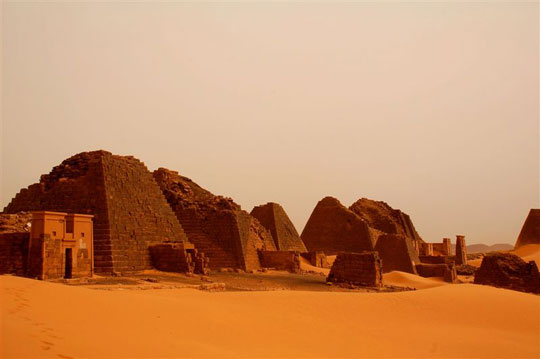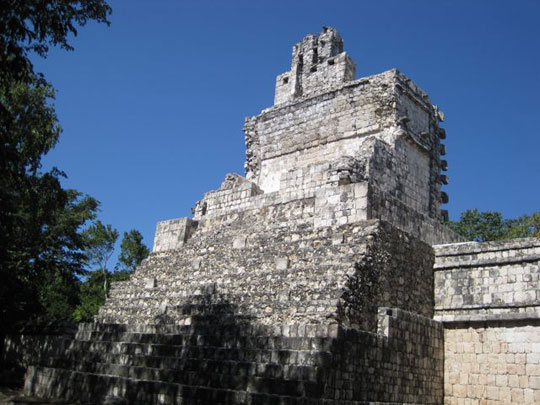Many world heritage sites are threatened
The warming of the earth caused many pyramids to be buried under sand, mummies in decomposed ice and collapsed temples.
>>>Bad prospects in 2060

The pyramids in Meroe, Sudan are subsiding to the sand by climate change. (Photo: abc.net.au).
Henri-Paul Francfort , a scientist working at the French National Institute of Scientific Research (CNRS), told AFP that, because the average temperature of the earth gradually increases, the world's ice blocks melt, expansion, sea level rise and the strength of storms also increase. For example, the melting of the permafrost is threatening ancient mummies in the Altai Mountains, Siberia, Russia.
Scientists warn that sea level rise will erase a series of archaeological sites along the coast , in which the Pacific islands face the greatest risk. In Tanzania, coastal erosion erodes a wall of Kilwa fortress - a Portuguese colonial building built on the coast of an island in 1505.
In Bangladesh, the city of Panam, the capital of the kingdom of Bengal from the 15th to the 19th century, suffered from frequent floods. UNESCO put Panam on the list of 100 properties threatened by climate change.

Tabasqueno temple in Mexico. (Photo: megalithic.co.uk).
Dominique Michelet, another CNRS scientist, said that an increase in unexpected weather events - like storms - is also a threat to heritage. According to him, the Chan Chan city in Peru, being destroyed by floods. Chan Chan used to be the capital of the ancient Chimu empire.
Similarly, Tabasqueno temple in Mexico - a famous legacy left over from Mayan civilization - was seriously destroyed by two storms in 1995.
' Archaeologists have tried to reinforce the temple, but since the water is too large, it collapses inside ,' Michelet said.
Sand is one of the most feared enemies of archaeological sites in the context of the increasing power of storms. For example, in Sudan, sand dunes engulf the pyramids of Meroe city - the capital of a powerful kingdom from the 3rd century BC to the 4th century AD. In Oman, two super typhoon Gonu (2007) and Phet (2009) completely buried archaeological sites dating from the 5th and 6th millennium BC under the sand.
Michelet warns that it is necessary for UNESCO to identify legacies that are at risk of disappearance due to climate change.
' Archeology is part of human memory. Therefore, human beings need to implement radical solutions to protect the heritage from the effects of climate change , 'Francfort said.
- Confucius, Confucian, Confucian - Chinese
- Sacred sites of Baha religion in Haifa in the west of Galilee
- Ban Chiang archaeological site
- Historical relics in the ancient city of Mtskheta
- Google will take you to visit historical sites with virtual reality technology
- UNESCO registers additional world heritage sites
- Ancient city of Thebes and its archaeological sites - Egypt
- I tried Sơn Trang and Grammy Temple - China
- Baroque churches - Philippines
- Di Hoa Vien - World Cultural Heritage in China
- Secrets - World Cultural Heritage in China
- The ancient 'impregnable' fortress was built near the Dead Sea
 Is the magnetic North Pole shift dangerous to humanity?
Is the magnetic North Pole shift dangerous to humanity? Washington legalizes the recycling of human bodies into fertilizer
Washington legalizes the recycling of human bodies into fertilizer Lightning stone - the mysterious guest
Lightning stone - the mysterious guest Stunned by the mysterious sunset, strange appearance
Stunned by the mysterious sunset, strange appearance China's 'sand-eating monster' devours 40 acres of desert a day, likened to a giant money-printing machine
China's 'sand-eating monster' devours 40 acres of desert a day, likened to a giant money-printing machine  Japan struggles to keep its 'deserts' from turning green
Japan struggles to keep its 'deserts' from turning green  Top 4 skills to escape when buried in sand
Top 4 skills to escape when buried in sand  China invents giant 'net' to help cover deserts with trees, making the world admire
China invents giant 'net' to help cover deserts with trees, making the world admire  Solutions to help replenish beach sand
Solutions to help replenish beach sand  Cause of red sand flood in Binh Thuan
Cause of red sand flood in Binh Thuan 